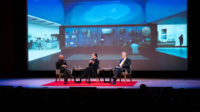Architectural Record: Thanks for taking the call. You’re probably very busy.
Nader Tehrani: No more, no less than on my regular days.
Which are like what?
I usually get up with the sunrise, which is early this time of year. I run between 4 and 6 miles. I usually bike another 14 or 16 miles. I get into the office about 8:30. I try to block off the first two hours for working independently; then I do round-table meetings with the different teams in the office.
It sounds like NADAAA has a lot of work.
We have some very exciting projects, which have catapulted our practice from a small boutique firm to a much larger animal. But we’re trying to keep it to about 40 people.
Will you continue to practice?
The premise of the appointment was to engage a dean who is trying to merge practice and pedagogy in meaningful ways. I don’t mean a conventional professionalization of the curriculum, not at all; I mean looking at ways in which academic research can alter the way architects work.
I was told you won’t talk about the school’s financial situation.
It’s not that I won’t talk about it; it’s just that I don’t know anything about it. Simply said, it was not part of my education in the interview process. I will learn more as we go on.
Will the financial problems affect the quality of the program?
Cooper did incredibly well this year in admissions. We did not need to go into the reserve, as it were—we got the top picks that we were after. Meanwhile, there’s nothing in my budget that’s been compromised. If anything, we’ve got a healthy discretionary fund. The incoming students should be quite excited.
You must know a lot about architecture education, having designed three architecture schools.
I’ve designed more than three architecture schools. Three are built or under construction.
What have you learned from those experiences?
You learn that no two architecture schools are the same. Their cultures, their philosophies, their finances vary a great deal. In extreme circumstances, it’s almost as if you’re comparing a school of agriculture with a school of dentistry. Having said that, there are some common issues. One is that the ideal of one person, one desk is showing itself to be more and more unaffordable. We’re researching alternative studios where scholarship and design get blended in the library, where making and design get blended in the fabrication lab, where exhibition and design get blended in the galleries.
What’s special about designing a school of architecture?
Your building ends up beings scrutinized as a pedagogical object. It becomes a de facto didactic instrument. So we’ve been quite self-conscious about the ways in which questions of integration, sustainable integration, are addressed.
Sustainable integration?
In the Toronto building, the way in which we integrate daylighting, the structural system, and the hydrological performance of the building — how the roof drains into cisterns for that are used for irrigation — all of that is done with one move.
What have you learned from visiting the Cooper Union building?
I had never been to the building before, except for a lecture in the basement. I found it’s a great environment in which to learn. The heart and soul of the school is the third-floor design studio; from first to last year, everybody’s in that same space.
Is your goal to strengthen the coherence of the school?
I want to maintain the intimacy of Cooper, but I’d also like to foster the productive friction we saw at, say, the Architectural Association when Alvin Boyarsky ran it [in the 1970s and ’80s].
Both your former Office dA partners have new posts as deans, El-Khoury at the University of Miami and Ponce de Leon at Princeton. What do you make of that?
It’s a great coincidence. But what unites us is that we were educated on the Harvard-RISD axis. My name means “from Tehran,” but if you asked me where I was from, I’d have to say I’m from Harvard and RISD.



Post a comment to this article
Report Abusive Comment